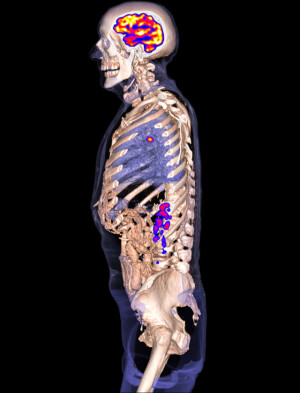by
Carol Ko, Staff Writer | June 10, 2013

Siemens' new Biograph mCT Flow
with FlowMotion™ technology
On June 10th at the Society of Nuclear Medicine and Molecular Imaging Annual Meeting in Vancouver, British Columbia, Siemens Healthcare unveiled two new systems that constitute a big leap forward for molecular imaging, according to the company.
First, the German engineering firm debuted its Biograph mCT Flow PET/CT system — the world's first continuous motion PET/CT system.
The machine is designed to address the problems physicians encountered with regular PET/CT stop-and-go image acquisition, which often requires additional overlapping scans in areas of the body that require higher image resolution, such as the head and neck.



Ad Statistics
Times Displayed: 173588
Times Visited: 3165 For those who need to move fast and expand clinical capabilities -- and would love new equipment -- the uCT 550 Advance offers a new fully configured 80-slice CT in up to 2 weeks with routine maintenance and parts and Software Upgrades for Life™ included.
A continuous motion system eliminates this problem by slowing down and gathering higher counts in areas of the body that demand it, while speeding through other parts of the body that require less attention, such as the legs.
"Now we can customize and adapt these scans to the personal anatomy of the patient," said James Williams, CEO of the molecular imaging unit at Siemens.
Additionally, in static stop-and-go acquisition, any part of the body captured at the edges of the detector's field of vision may be subject to loss of accuracy.
Continuous motion scanning eliminates this problem because each part of the body passes through the detector's "sweet spot" at least once, allowing for more accurate images.
Siemens has also debuted another new system called the Symbia Intevo, which aims to overcome some of the long-standing limitations of traditional SPECT/CT by totally integrating SPECT and CT, resulting in what the company is calling a brand new modality — xSPECT.
Though traditional SPECT/CT mechanically fuses SPECT and CT images together, the inherent mismatch between SPECT and CT requires that SPECT be used as the starting frame of reference, resulting in a degradation of CT's anatomical specificity.
Using new advanced detector technology, Symbia Intevo is able to look to CT as the common frame of reference, giving doctors valuable anatomical detail that may help them differentiate cancer from other forms of disease, which is notoriously difficult to do in traditional SPECT/CT.
"We're not not only able to diagnose the level of the problem but what is causing the problem in each specific patient," said Dr. Jerry Froelich, director of nuclear medicine and molecular imaging at University of Minnesota.
According to Siemens, the accuracy of this system also allows physicians to do something on SPECT/CT that it couldn't do before: quantification.
Though therapeutic monitoring had always been the aim of SPECT/CT, the modality's lack of fine accuracy has hindered its use for this purpose. Now, according to Siemens, this may finally change with the debut of xSPECT and its ability to quantify disease.
Biograph mCT Flow has received 510(k) clearance from the U.S. Food and Drug Administration (FDA), and Symbia Intevo is currently pending clearance.

